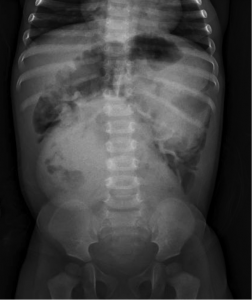Just Constipation?: Functional v. Organic Causes of Slow Stooling (or Defecation Delays)
Mom brings a previously healthy 11 month-old male to the Pediatric Emergency Department because the boy has not had a bowel movement for four days and seemed “fussy”. He has continued to eat, is not vomiting, having fevers, experiencing rectal bleeding, and is not lethargic or inconsolable. His vital signs are completely normal, and he is well appearing and playful in mom’s arms. The abdomen is mildly distended but soft, and there is a firm palpable mass extending from the right lower to right upper quadrant. CBC, BMP, UA are normal. The initial KUB obtained in the ED is shown below:
Functional constipation is often associated with dietary changes, stool with-holding and trouble toilet training, decreased fiber intake, or decreased liquid intake. It accounts for 95% of cases of constipation in kids.
In most cases of constipation, history and physical exam can lower the suspicion for an organic cause and the patient can most often be discharged with the stool softener or poop potion of your choice with outpatient follow up.
When considering organic causes, think about some “alarm signs” or physical findings that would warrant further work-up.
Alarm Signs:
- Was there delayed passage of meconium which might suggest CF or Hirschsprung’s disease?
- Has there been severe abdominal pain or rectal bleeding?
- Any urinary incontinence to suggest spinal cord abnormality?
- Are stools “ribbon-like”?
- Has there been significant weight loss, or is the patient falling off the growth curve?
Physical Findings:
- Are there any focal neurologic findings, especially involving the lower extremities and the rectal exam?
- Is there any abnormal GU anatomy such as:
- Lumbosacral dimple or lower spine abnormalities
- Perianal fistula
- Tight anal canal
- Anteriorly displaced anus
- Is the abdomen significantly distended or are there palpable masses that would suggest obstruction or mass?
In the KUB obtained on this patient, there was a visible right-sided abdominal mass that was read as “likely representing stool”. The patient was admitted and taken to the OR for stool evacuation under general anesthesia. The exam was anatomically normal, but a rectal biopsy demonstrated “absence of ganglion cells in the mucosa”. In this case, the diagnosis was Hirschsprung’s disease. The only finding on initial evaluation that led to further work-up was the palpable abdominal mass. Even though more than nine times out of ten, constipation is just constipation, this case serves as a good reminder to keep an open mind when obtaining the initial history and physical examination and to look out for any alarm features that would warrant further testing.

